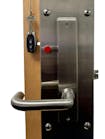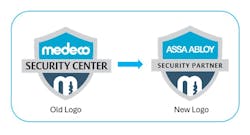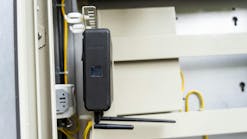Commercial Multipoint Locking: A Host of Applications
As a resident of New York City, I’m very aware of people using multiple locks on a door to protect themselves. But that isn’t the same as multipoint locking.
A single auxiliary multipoint lock should retract all the locking bolts with a single action. An integrated multipoint lock, such as a mortise lock or deadbolt exit device, retracts all deadbolts and a latch — if there is one — in one motion, meeting all single-motion egress codes.
Building Hardware Manufacturers Association recognized the growth of multipoint locks by publishing its first multipoint locking standard in 2014. Previously, multipoint locks were referenced in the Auxiliary Locks standard. However, the proliferation of multipoint lock designs and their use for a variety of purposes, including forced entry, dictated the demand for an independent standard, which was accepted and published by ANSI.
Modern History
Multipoint locking always has been prominent on European doors. However, in the absence of door standards there, multipoint locking is used for security and door-fastening purposes to prevent warping.
Fortunately, the North American market has uniform door standards and the preeminence of hollow metal doors and engineered word doors. As a result, standard door preparations and heights — the large majority not exceeding 7 feet tall — minimize warping concerns. Standard latch locks, cylindrical or mortise, meet the fastening and basic security needs.
The oldest commercially available multipoint lock produced in the United States was the Fox Police Lock. Fox originally produced a bar that barricaded the door by locking into a plate on the floor, operable only from the interior. Later, it developed a two-point horizontal lock operated by a turnpiece on the interior or a rim cylinder that had a special shaft tailpiece from the exterior side. Look at movies set in New York from the ’70s or ’80s, and you’ll see them on warehouse or loft doors.
Protection against apartment intrusions played a large role in the development of the modern multipoint lock used for forced-entry protection. A growing crime wave in major cities had the population desperate for something better and more effective than placing multiple jimmyproof and deadbolt locks on a door. Imported retrofit multipoint locks began to take hold.
Retrofit locks, however, were limited by their installation requirements. Expensive jigs, long drill bits and guides were required. Retrofitting could violate the code on doors, because the doors hadn’t been tested with the locks. Trained installers weren’t available in most of the country, and the cost of all the unique equipment wasn’t something most locksmiths were willing to undertake. Although a few surface-mounted four-point locks were used, the imports required profile cylinders, which weren’t common in North America at the time.
Two-point vertical locks were produced in the United States, but they were used primarily for specialty applications, such as the Adams Rite lock for an inactive leaf on a pair of aluminum doors. The first retrofit four-point security lock was the MP Police Lock, introduced by Securitech in the mid-1980s. This took the concept of the retrofit lock into the standard installation world and replaced the profile cylinder with a standard rim cylinder.
It was an immediate success and has been used in thousands of applications, including data rooms, equipment rooms, storage rooms within retail stores and other locations where specialized retrofit locks had been used. Modifications over the years have included a bolt-position signal, which ties into an alarm system to ensure the room has been locked at the end of the day.
Panic rooms for major corporate executives also took full advantage of the security attributes of multipoint locking. In many cases, a hidden door was constructed behind the executive’s desk. In the event of an emergency, they would enter the safe room and use the multipoint lock as a time-delay measure. Gracie Mansion, the mayor’s residence in New York City, is one such application. Libraries also use multipoint locking to secure their most valued possessions.
The New York City Transit Authority was another application of multipoint locking.
“While multipoint exit locks solved the rear-entry issue, burglars would drop through the roof or break through an adjoining storefront when they couldn’t break in through the back door,” says Nelson Nieves, a loss prevention manager. “The storage rooms would contain extremely valuable merchandise. We would line the rooms with steel plates, but there still were break-in issues until four-point locks were applied to the doors. They worked out great.”
Retail Applications
Probably the largest area where multipoint locking has been a game-changer has been rear exit doors, particularly in the retail environment. Several products have solved the code-compliance issue while providing forced-entry protection, and many break-ins have been thwarted.
Continuously deadbolting the door with multipoint locking and meeting single-motion egress requirements can be accomplished by automatic deadbolt locking. The latest models feature concealed or surface-model units, with the latter shipped assembled in a stainless steel housing that’s thru-bolted to existing or new doors.
Sanford Siegel, former loss prevention manager at Gamestop, worked tirelessly to design the right type of door reinforcements, in addition to adding a multipoint exit lock on the rear door and stock-room door of the stores.
“Securing back doors and saferoom doors in many instances provides limited protection to a break-in,” he says. “The Trident and MP Police Lock multipoint locking systems we used enhanced traditional door hardware and mitigated a significant amount of the risk of being victimized by a break-in.”
The legalization of cannabis in many states across the United States has fueled a demand to secure perimeters of grow houses, dispensaries and related facilities. In addition, interior doors to critical areas as well as counting rooms have benefitted from the superior forced-entry resistance of multipoint and automatic deadbolt locking.
“We have had many attempts with burglars trying to gain entrance with two crowbars at the same time on metal doors,” says Mike Hinsley of Wrangler Safe and Lock in Denver. “Over the past 6 years, we have put hundreds of the Tridents and ABM multipoint locks on our marijuana industry customers’ locations. Our customers that had a single-point panic bar or lock that was burglarized easily with a crowbar have now switched to multipoint locks for peace of mind to protect their products.”
Special Applications
Multipoint locking has provided an effective way to fasten the door in place, as well as protect against forced entries, in several special applications. After a rash of synagogue burglaries in the 1990s where valuable Torah scrolls were stolen from arks, custom multipoint locks were created to match these special doors. Large sliding doors also took advantage of the ability to project vertical deadbolts and prevent crowbarring the doors off their tracks to enter.
Windstorm shelters and other shelters also benefit from bolting the door to the frame at multiple locations. A variety of certified products, covering exit devices, full-function mortise locks and auxiliary deadbolt locks (used on mini-doors serving as window shutters) meet the needs of FEMA 361.
Psychiatric seclusion rooms and timeout rooms in school also use multipoint locks successfully. These doors typically swing out into the corridor to prevent patients or students from barricading themselves against the door. Although codes permit psychiatric seclusion rooms to be locked while occupied, time-out rooms provide a unique challenge. Students in these spaces must be under constant supervision, so another name for time-out room locks is “constant supervision locks.” Instead of protecting against people breaking in, these locks secure against people breaking out.
Multipoint timeout room locks are mounted on the exterior side of the room, not the standard interior side. They also function in the opposite manner of ordinary locks. The teacher or school administrator must depress the lever to project the deadbolts; let go of the lever, and the door unlocks. This meets local code requirements, because a student never can be locked in the room: Someone must hold the lever down while the room is occupied.
Elements such as motorized control have been added to allow remote activation and release, so multipoint locks will continue to evolve as society places new demands on functions and features.
Mark Berger is president and chief product officer of Securitech Group Inc.
New York Subway: A Multipoint Success Story
There are 475 station in the New York City subway system. Those stations have about 2,500 storage areas, as well as other critical doors for electronic signaling, switching equipment, and maintenance and repair equipment necessary for the operation of the system.
These rooms had been secured with an assortment of locking devices, from shrouded padlocks, to deadbolt locks, vertical drop bolt locks, hockey puck padlocks that have custom-made hasps. None of them succeeds in keeping out the miscreants who want to get in those areas. The locks also created code-compliance issues. Finally, the criminals who were breaking in not only would ruin the locking devices, but they also frequently damaged the door frame, sometimes to where the door had to be replaced.
This presented a major problem for authorities. The NYC Transit Crime Prevention Bureau, where I served for more than 10 years, was tasked with finding a way to solving the problem. We obtained four-point locking devices to prevent or minimize our loss.
After we started installing these locking devices across the system, we virtually eliminated the problem. We installed more than 1,000 of these devices without a single case of them being violated. This has been a great success story for us.
— Bernard Jacobs, CPP






